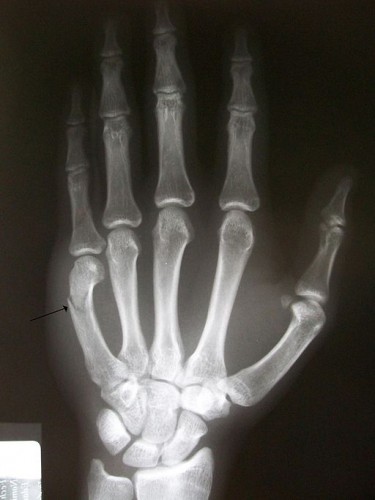by Dayle Carhart, SPT
PT For A Common Injury Among Boxers
Not only has the sport of boxing been around for ages, but now boxing is taking the fitness world by storm. Boxing is a good workout for a variety of things such as power, agility, endurance, cardiovascular conditioning, and it also helps to teach self-defense skills. As with all sports and workouts, however, there is a risk for injury. For those who box professionally or not, hand injuries are especially common. One injury in particular has been named the “boxer’s fracture” because of its high prevalence among boxers.
What is the Boxer’s Fracture?
A boxer’s fracture is a fracture to the 5th metacarpal, or the long bone of the pinky finger that connects the wrist to the finger bones themselves. The fracture site is typically at the neck of the metacarpal, which is located just below the knuckle of the pinky finger. This type of fracture occurs when the hand hits an object in the position of a closed fist, and it occurs more easily when the hand is unprotected.
Symptoms of a Boxer’s Fracture
Symptoms of this type of fracture vary depending on the severity of the injury, but most often include painfulness to touch, swelling, pain with gripping objects, and knuckle and/or pinky finger deformity.
Treatment for a Boxer’s Fracture
Treatment for this fracture depends on the severity. For simple fractures, reduction (aligning the bone properly) and immobilization are common. Immobilization can range from taping the pinky finger to the ring finger, to having the fingers and/or hand in a splint or cast. Immobilization typically lasts for a period of 4-6 weeks but depends on the symptoms and updated x-rays. Operative treatments are used for more severe fractures with larger bone deformities. The most common operative treatment is placing pins or wires through the finger bones while the fracture heals for optimal bone alignment and reduced finger deformity.
How can a Physical Therapist Help?
After the fracture heals, and the immobilizer, pins, or wires are removed, it is common to experience loss of hand strength, loss of grip strength, and reduced motion and ability to move the finger and wrist. A physical therapist can provide hands on techniques to improve motion and any residual pain, as well as teach patients exercises to improve grip strength, wrist strength, and motion of the fingers and wrist. Along with the hand, strength of other muscles, such as those around the elbow and shoulder, can be affected since activity of the injured arm is limited with the hand injury. A physical therapist can help by providing skilled services to the affected hand as well as to other muscles and joints affected by the injury.
Are There Ways to Help Prevent a Boxer’s Fracture?
Appropriate hand protection is used to try and prevent boxers’ fractures from occurring and to protect pre-existing injuries. Kyle Provenzano of Schott’s Boxing, who is an athletic coach, cut man, physical education teacher, and a former standout amateur boxer, talked to me about what can be done to help prevent these fractures. For boxing classes and training, the hand is wrapped, and a sponge can be placed on the knuckles and secured with tape to allow for extra padding and shock absorption. For an actual fight, only a certain amount of gauze and tape is allowed, no sponge, so they try to tape the area more, but it’s harder to protect a pre-existing injury. Giving your hand a rest is also a good way to prevent injury. Repetitive force on an area can cause excessive stress to the region, making it more vulnerable to injury.
Boxing is a great way to get in a fun, high intensity work out. There are many benefits of boxing, both physical and mental, and it is good to know how you can prevent boxing injuries from occurring.
For more information on preventing or treating boxer’s fracture, or to make an appointment for an evaluation or treatment, contact us at one of our two physical therapy clinics at 518-289-5242 (Malta) or 518-289-5242 (Queensbury). Visit our physical therapy blog for information on all types of sports injuries and how physical therapy can keep you in the game!







